How to Create a (Memorable) Personal Brand in 2024
In case you haven’t heard, personal branding is ‘in’ and here to stay. In the age of social media, brands are ditching the faceless vibe and opting for a more personal touch.
They are throwing out the corporate rulebook that says, “You have to be professional and hide your personality in order to be successful.” Brands are waking up to the fact that people buy from people and, turns out, people want the journey, not just the deliverables. They crave connection and that unique personal touch.
So, out go the generic brand names, and in come the personal ones. Because what’s more personal than your own name?
But what exactly does it mean to have a personal brand?
I’m spilling the beans—and not just the basics of “how to build a personal brand”, but we’ll be diving into how to craft a memorable personal brand because there’s a difference.
In this blog post, you’ll learn what it is, why it’s a game-changer, key elements to consider, and real-world examples.
Ready? Mmmmk, let’s do it!
First things first…
What Is a Personal Brand?
In essence, a personal brand is YOU!
It’s your name attached to the brand, defining your reputation and how others perceive you. Your personal brand encompasses your skills, values, and how you choose to present yourself to the world.
Personal brands are gaining popularity because they revolve around real individuals, making them inherently unique and more relatable. Building a memorable personal brand is about standing out, being genuine, and leaving a positive impression by showcasing who you are, what you value, and, ultimately, what you bring to the table.
Why Does Personal Branding Matter?
Great question!
Building a personal brand showcases your authenticity, builds trust in your community, and establishes credibility within your industry…
Authenticity:
Just be yourself! How many times have you heard that advice? It’s easier said than done, right?
The fact is, embracing your true authentic self, is a key ingredient in crafting an effective personal brand—and when I say “true” I mean TRUE authentic self—people can smell ya from a mile away if you’re not being genuine, so please, don’t fake it!
Trust:
When you can genuinely express who you are, your personal brand will start to build trust, which will naturally start to cultivate a loyal community.
Then, the more consistently you show up ethically and authentically, the more trust you’ll build over time, which will allow people to connect with you on a deeper level.
Credibility:
Once you’ve gained their trust, the next step is establishing credibility.
This will naturally happen as you start to showcase your expertise, creating a name for yourself as a leader in your space. Your credibility, can and should, lead to increased inquiries, referrals, and an overall reputation for being the go-to person for whatever “thing” you’re trying to be known for.
How to Create a Memorable Personal Brand
Creating a personal brand that truly stands out requires a lot of work!
Let’s dive into the key elements that make the difference between an average personal brand and one that’s hard to forget.
01. Define Your “why”
First, you’ll need to decide if building a personal brand is right for you, then once you’ve decided, you’ll need to get crystal clear on your why—create a mission statement that reflects your purpose, goals, and overall vision for the future of your personal brand.
Here are some simple questions to help you define your why:
What Drives You?
Think about what excites you the most. What gets you out of bed in the morning? What topics, causes, or activities do you find yourself consistently drawn to? Your why often stems from that deep passion burning inside you.
Who Do You Want to Impact?
Consider the audience or community you want to serve or influence through your personal brand. Who do you want to reach, inspire, or help? Whose lives do you want to impact positively? Knowing your audience can give your brand purpose and direction.
What Change Do You Want to See?
What kind of difference do you want to make through your personal brand? What positive change are you passionate about making within your industry, community, or the lives of others? Your why might be all about creating that change.
How Do You Define Success?
Reflect on what success truly means to you. Is it about personal fulfillment, making a difference, or something else entirely? Understanding your own definition can keep you focused on what truly matters rather than getting distracted by someone else’s version of success.
Why Does Your Voice Matter?
What makes your perspective unique? Why should people listen to what you have to say? Recognizing your values, skills, and unique experiences can give you the confidence to share your point of view.
Taking the time to answer these questions and craft a clear mission statement, will help you start to build a solid foundation for your personal brand. It will also help you remember your why if/when you start to doubt yourself or become distracted.
02. Establish Your Values
Values are everything! People want to know what you care about and why. They want to know what is important to you because then they will be able to see if your values match their own—if they do resonate, that creates a deeper connection and can even lead to increased sales.
For example, within my own personal brand, I value sustainability and giving back to the planet. That’s why, for every product or service I offer, I’ve committed to planting a tree in collaboration with our partners at One Tree Planted.
This comes at no extra cost to my clients, and although it’s just a small gesture, it resonates deeply with those who share similar values. My clients appreciate knowing that our collaboration extends beyond mere transactions, leaving a lasting positive impact.
It’s important to take the time to reflect on your values and their significance. They’re not just a part of your personal brand—they shape how potential clients perceive you. In fact, they could be the deciding factor in whether they choose to work with you or someone else!
03. Discover Your Unique Point of View
Okay, I know we’re all sick of hearing the term “point of view” thrown around on the internet—especially when people think that slapping “POV” in front of anything makes it an actual POV…🙄
Buuuut taking the time to discover your own point of view truly will help you stand out as a memorable personal brand.
Take Ramit Sethi, for example—he is known for his unique perspective on the relationship people have with their finances. Unlike other financial experts who emphasize setting harsh restrictions as the only way to handle money, like ‘don’t buy lattes’ or ‘never go on vacations’ Ramit encourages a different approach:
“Spend confidently on the things you love, and cut back mercilessly on the things you don’t.”
He discusses his philosophy in more detail in his best-selling book, I Will Teach You To Be Rich, guiding his audience to rethink their lives in the context of personal finance. He also has a killer website where you can find links to his podcast, blog, and Netflix show—Highly recommend, btw!
04. Be Relatable
This is a biggie…
If you’re building a personal brand, you better make sure that people can personally relate to you in some way, shape, or form.
There are a bunch of different ways that you can do this, but some of my favorites, involve adding personality to your website, your blog, and sharing behind-the-scenes of your brand on social media—even if it’s as simple as posting a photo of your morning coffee, favorite song, or a daily walk view, the people want to know!
I know it may sound silly to post something that feels so insignificant, but you’d be surprised by how much engagement you’ll receive when you post relatable content.
Ultimately, people want to feel like they can relate, so if they see you drinking out of a Stanley Cup, and they also have one, then they will automatically feel connected to you because you share a common interest.
For the record, I do NOT, nor will I ever own that godforsaken cup, #sorrynotsorry—it’s just not part of my personal brand, BUT I can appreciate the strong brand loyalty they’ve created—maybe I’ll write a blog on that at some point 👀
05. Find Your People
To niche, or not to niche? The age-old question.
In building your personal brand it’s important to find your people. If you’re a service provider, this can look like working with a specific industry, but it doesn’t necessarily have to.
For example, I love working with people who care about people and the planet, so it’s niche in the sense that my people share the same values, but not necessarily limited to a specific industry. I kind of think of it like a “vibe check” for lack of a better term.
The key here, is taking the time to figure out who you want to speak to and why.
06. Create A Killer Client Experience
Just because you’re out here crafting your own personal brand, doesn’t mean it’s okay to slack on the client experience front. If anything, I’d argue it’s even more crucial!
Honestly, if your clients have a lousy experience, they’re going to take it personally, and who can blame them? I’ve seen this play out with tons of online service providers who have built personal brands, not giving their client experience the attention it deserves. It’s an underestimated aspect that takes you from just having a personal brand to becoming one that is truly memorable.
07. Show Your Personality—Duh!
Think of your personality as the cute little bow that ties everything together. People want to see your weird quirks and mannerisms. It’s a massive part of what makes you YOU!
Your personality directly reflects how you authentically show up and embody your values. Honestly, your personality is the biggest differentiator in setting you apart from other personal brands.
Okay, but how do I show my personality?
Great, question, I’m so glad you asked!
Here’s a short and sweet lil list of unique ways you can show more of your personality in your personal brand:
Branding visuals:
AKA your fonts, colors, imagery, etc. The visual vibe really sets the tone for what people can expect and it should be dripping with your personality. If you don’t already have branding set in place, you can go the DIY route, but I strongly suggest you hire a brand designer—like me! 😉
Social media:
Showing people a day in your life via a vlog-style reel or by posting stories are great ways to showcase your personality! This can be as simple as documenting your morning routine, sharing what you’re currently reading, listening to, cooking, watching, buying, etc.
Bonus points if you can leverage the power of your brand visuals AND social media by adding your brand colors to your Instagram stories! This is super easy to do, here’s how…
- Step One: Grab Your Brand Colors
Your color palette and hex codes should have been provided to you by your brand designer via your branding guideline document. However, if you’ve gone the DIY route, you’ll want to create your own color palette (I suggest sticking to 5-6 max).
Once you’ve got your color palette sorted, head over to Canva and create a set of circles or squares to keep your color palette organized, and then download it as a PNG.
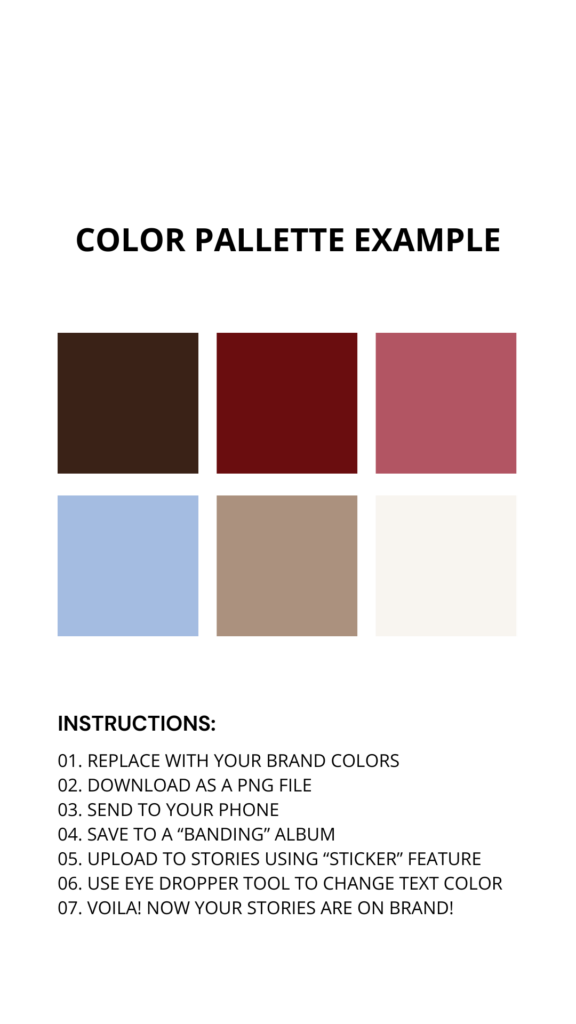
- Step Two: Send an Image of Your Color Palette to Your Phone
Next, you’re going to want to send that image over to your phone—I suggest creating an album on your phone titled “branding” where you can save the image of your color palette as well as other branding assets like imagery and other visual elements like your logo so you can easily access them.
- Step Three: Customize Using The Sticker & Eye Dropper Tool
Now, the next time you go to create a story, all you’ll need to do is use the “Sticker” feature in Instagram to upload your branding image and use the “eye dropper” tool to change the text on your screen to the exact color of your brand! How cool is that?! You’re welcome 😉
PS…just make sure you delete the photo of your color palette before you hit post.
If you’re a visual learner, like me, see the images below to help you out!
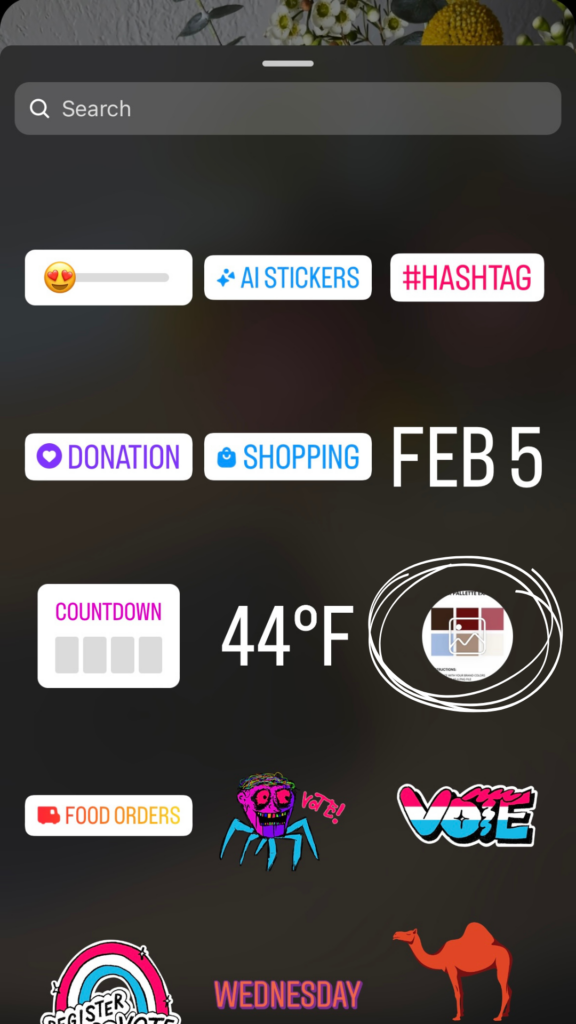


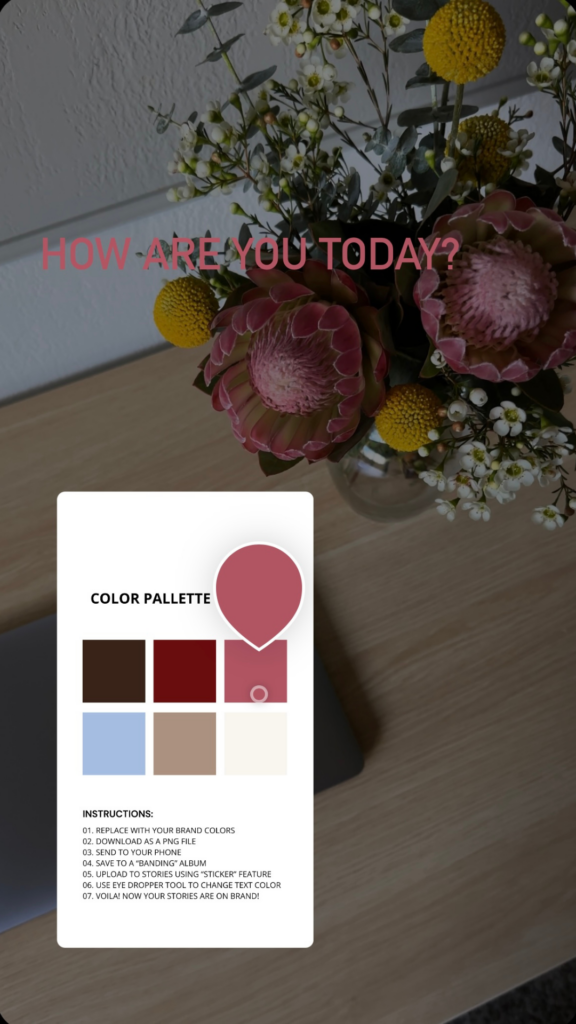
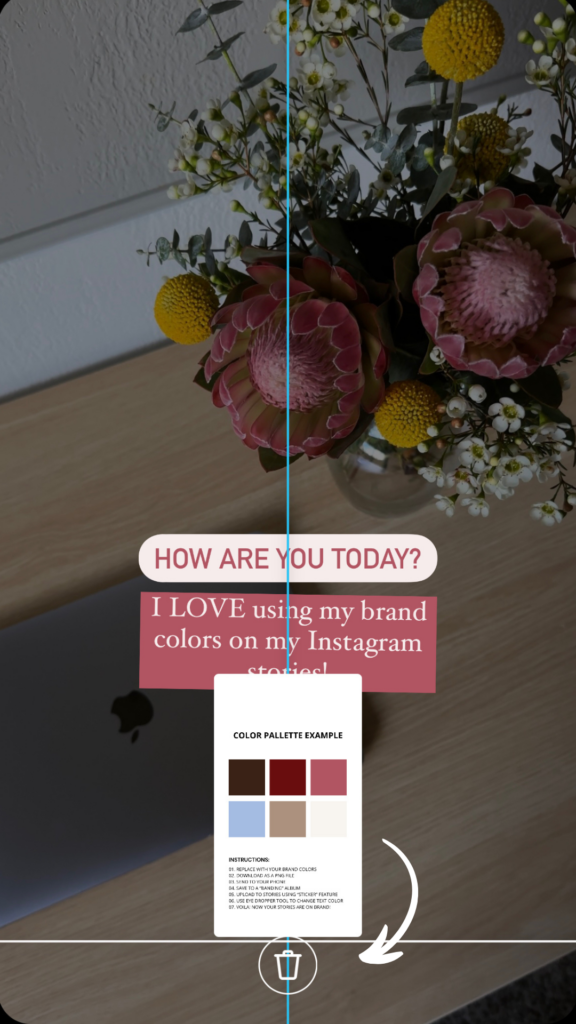
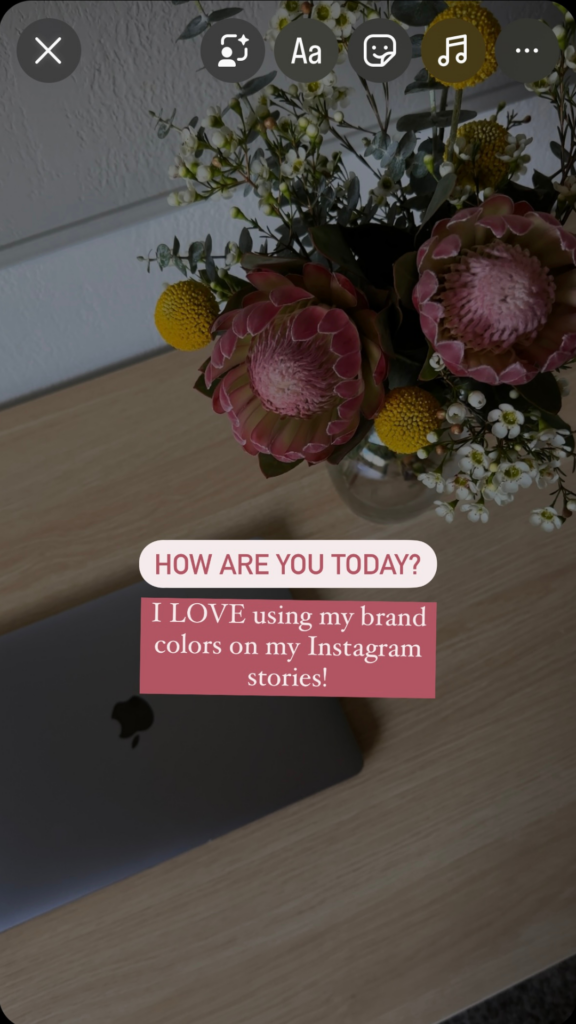
Your outfit:
How you dress says a lot about you and your personality. For example, are you a casual, laid-back girlie who lives in jeans, sneakers, a plain white tee, and a baseball cap (ahem–that’s me!) or are you into wearing dresses, heels, bows, and doing your hair a lil fancy?
Next time you get dressed, think about how you can be “on brand” through your outfit. Have a jacket that matches your brand colors? Wear it! Doing this will also help you become more memorable to your audience and they will start to associate your brand colors, pieces of clothing you wear, and accessories you carry adding that personal touch to your personal brand. Also, it’s like super fun! Who doesn’t want to match their brand?
Create an emoji bank:
Emojis are a great way to add a fun splash of personality to your brand! Emojis really show your vibe and add that relatability aspect between you and your audience (similar to the Stanely Cup example I mentioned earlier).
For example, if you’re personality is bold, fun, and adventurous, you might use this set of emojis 🤠❤️🔥🤸♀️
Whereas if you’re more laid back, and calm, this set of emojis 😌🌅🤍 might better represent your personal brand.
I like to keep a lil emoji bank in my Notion hub and on my phone to make sure I’m staying consistent.
Which just so happens to bring me to my next point…consistency…
08. Be Consistent
Ah, consistency—another term we hear thrown around incessantly. But honestly, there is a reason for it. Consistency is key to creating a memorable personal brand.
To truly be memorable, you have to show up consistently—not necessarily every day, but regularly enough to leave an impact. So, find a frequency that works for YOU.
Also, when I say consistency, I don’t just mean when you show up but also how you show up. If your visuals are constantly changing or your messaging is all over the place, people are going to get confused, your trust and credibility will take a dip, and they will eventually lose interest.
Which brings me to the last one on the list….
09. Hire A Professional Brand Designer
Yes, I am a brand designer, so obviously I had to include this on the list, BUT I’m not just blowing smoke–pinky promise!
If you want your personal brand to stand out and have a lasting impression, you’re going to want to hire a professional (hey, that’s me 💁♀️) to help you gain clarity on your messaging and create a strategic visual identity to match.
Creating unique and memorable visual identities for personal brands is one of my absolute FAVORITE things to do!
I have a one-week intensive branding package where I dive deep into your brand and together we collaborate to create aligned branding that visually represents you, and your vision, ensuring that it will not only feel one hundred percent aligned but also be memorable and attract the attention of the people you’re wanting to reach. It’s truly a transformative experience!
If you’re thinking, yes that’s what I need! Then head on over to my contact form to get the process started. I would be honored to work with you!!
Not quite ready to hire a brand designer? No problem—it’s a big step!
Here are some friendly DIY tips to keep your messaging and visuals consistent: use the same language everywhere, pick three fonts and a handful of colors to maintain a polished look, and create simple social media graphic templates, like for carousel posts, to keep things streamlined and cohesive.
Famous Personal Brands and What Makes Them Memorable:
I thought it would be fun to finish off this post by taking a look at some famous personal brands that are using their unique personality traits to stand out and leave a lasting impression.
Beyoncé – The Bold Icon
- Personality Trait: Bold
- Why: Beyoncé owns her boldness in epic performances, by speaking out on controversial issues, and by being her unapologetic self. She’s the fearless icon who doesn’t back down, and we love her for it!
Emma Chamberlain – The Relatable Trendsetter
- Personality Trait: Relatable
- Why: Emma’s taken the internet by storm over the last few years because she simply keeps it real. She’s great at sharing authentic, everyday experiences, creating a genuine and relatable connection to her audience that sets her apart as a trendsetter in the online space.
Coco Chanel – The Timeless Fashion Innovator
- Personality Trait: Timeless
- Why: Coco Chanel’s brand epitomizes timelessness. She has seamlessly blended elegance and innovation in the fashion world. Her creations transcend trends and leave an epic legacy that continues to influence the fashion industry.
Oprah Winfrey – The Inspirational Communicator
- Personality Trait: Inspirational
- Why: Oprah’s personal brand thrives on her ability to inspire through compelling storytelling and impactful communication. Her messages resonate deeply with her audience and have made her an influential figure in the world of inspirational communication. I mean, come on, who doesn’t LOVE Oprah?!
Jay Shetty – The Wise Motivator
- Personality Trait: Wise
- Why: Jay Shetty’s brand is built on wisdom and motivational content that speaks to a broad audience, making it super relatable. His thoughtful insights and profound wisdom based on his unique lived experience position him as a wise motivator for people seeking inspiration and personal growth.
Ramit Sethi – The Practical Financial Guru
- Personality Trait: Practical
- Why: Ramit Sethi’s personal brand is built on practical financial advice. He’s great at simplifying complex concepts by making them accessible and actionable, which empowers people to take practical steps toward their own financial success. Like I mentioned earlier, he has a ton of great resources on his website, so check em out if you’re on the hunt for some refreshing financial advice.
It’s Time to Craft Your Own Personal Brand
I hope this post really helps you understand what a personal brand is, why they are so effective, and how to make them memorable.
If you feel like you’re lacking consistency in your own personal brand, especially when it comes to your messaging and visuals, it’s time to make some change—lucky for you, I can help with that! Check out my one-week branding intensive where we will dive deep into your business to clarify your messaging and create a visual brand identity so you can show up confidently AND consistently 😉
Instagram Links Page Template
download now >>
Because Your linktree bio isn't doing you any favors.
Designed for showit
free!
Instagram Links Page Template